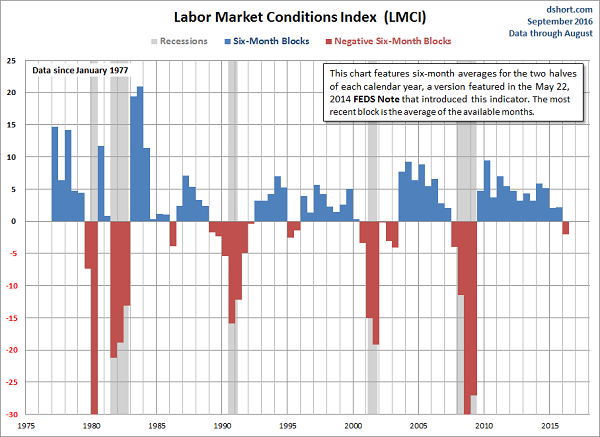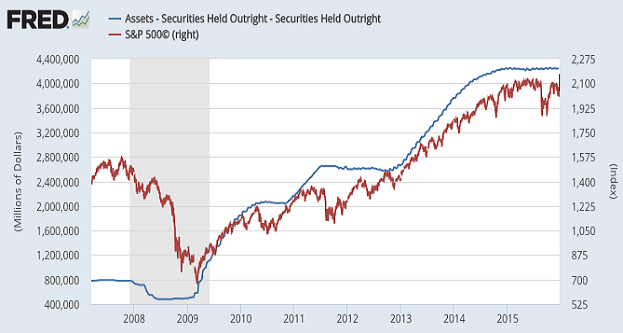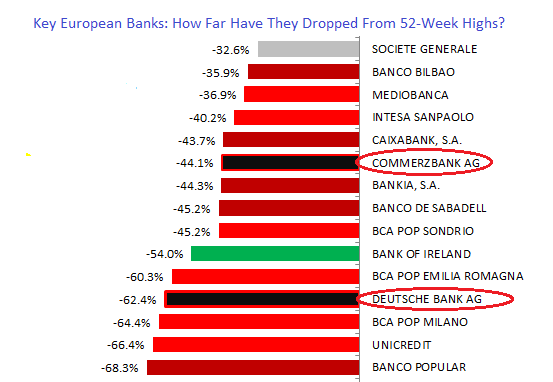The U.S. economy is barely expanding. Not only has growth slipped to 1.3% over the last 12 months, it has failed to reach the sub-par bar of 2% in three consecutive quarters. The big hope? 3rd quarter GDP could show modest improvement in hitting 2% – the deeply disappointing “New Normal.” (Note: There was a time when economists regarded 3% U.S. economic growth as average.)
Does the slowdown imply that a recession is on the immediate horizon? Perhaps not. Yet the ultra-weak recovery prompted the Federal Reserve to maintain near-zero overnight lending rates for 94 months. What’s more, Larry Summers’s prediction of secular stagnation is beginning to look mighty prescient.
The most recent data? Corporate capital expenditures (CapEx) are contracting. Company profit margins are falling. The speculative default rate has breached 5.5% for the first time since 2009. Even the highly touted health of the labor market appears suspect. The Federal Reserve’s own Labor Market Conditions Index (LMCI) has shifted into negative territory.

Ironically enough, the stagnation story does not seem to deter equity enthusiasts. For one thing, central bank bond-buying programs clear across the globe, accompanied by negative rate policy, have pushed yields to record lows to stimulate anemic economic activity. The rock bottom cost of capital encourages residential and commercial borrowers to bid up the price of real estate. Meanwhile, public corporations borrow cash to buy back stock with a shorter-term goal of supporting current prices.
(They should be spending far more money on capital expenditures like industrial buildings, equipment and computer networking upgrades as well as investing in marketing or R&D. Unfortunately, executives do not have faith that the proverbial “longer-term” offers tremendous promise.)
Secondly, negligible progress on the economic front is actually desirable to many Wall Street participants. Why? It means that the world’s central banks will never sell their bonds for fear of sending borrowing costs through the roof.
In contrast, imagine if countries actually found themselves in genuinely good shape. They’d be more inclined to raise overnight borrowing costs; they’d be more inclined to cease the reinvestment of maturing bonds; they might even sell assets back into the debt markets. In this instance, like every sustained rate-hiking, policy tightening campaign of the past, stocks eventually crater.
In fact, even in today’s “Thanks, Mrs. Fed!” environment, a domestic recession may not faze believers in the invincibility of central planners. The reason? Federal Reserve Chairperson Janet Yellen has expressed confidence that buying stocks in a future downturn “could be useful.”
Wait a second, what? Did we just learn what QE4 is going to look like? You betcha. According to Ms. Yellen, expanding into areas like equities is a “good thing to think about.”
For those who believe bull markets never die, it may be a wonderful thing to think about. Stagnation? Recession? Depression? No problem. As long as the Federal Reserve is willing to actively engage in a stock-purchasing program with electronic dollar credits, the market should always have the support that it needs. (At least in theory.)
Valuation? Irrelevant. Price discovery in a true marketplace? Non-existent. If the Fed expands its bloated $4.4 trillion balance sheet with stocks, junk bonds and other risky assets, there’s no telling how high the S&P 500 could fly. (Again, at least in theory.)

So that we avoid placing the cart before the horse, let’s clarify what the implications of Ms. Yellen’s acknowledgement are. The Fed is not buying stocks today. The Fed is likely to consider the possibility of buying stocks if an economic downturn or stock market downtrend materialized. What’s more, the Fed could not legally acquire stocks with electronic dollar credits, at least not without Congressional input. It follows that a fourth iteration of quantitative easing (QE4) involving stocks and other risky assets would not likely come to fruition without a near-bear experience (18%-19.5%) occurring beforehand. (Think 1998’s Asian Currency Crisis. Think 2011’s European Sovereign Debt Crisis.)
What could spark an approximate sell-off of 20% in U.S. equities? The recent evaporation of faith in one of the world’ s largest banks, Deutsche Bank (NYSE:DB), provides ample insight. Down more than 50% in one year – down as much as 90% since its 2007 heyday – Germany’s “too big too fail” financial institution is likely to need a Bear Stearns boost. (The world’s flow of credit sure as heck could not afford to see the German mainstay get the Lehman Brothers bankruptcy treatment.)
Indeed, investors often forget that credit flow is what makes the world’s economic engine operate. If Deutsche Bank or its chief competitor, Commerzbank (DE:CBKG), crumbled without a bailout of some kind, credit would seize up in a heartbeat. And yes, that’d look a whole lot like October of 2008 did.
How beleaguered is the European financial system? Wolf Richter of WolfStreet.com chronicled the trials and tribulations of the 29 banks that constitute the Eurozone’s ESTX Banks Index. Deutsche Bank, Commerzbank as well as Societe Generale (PA:SOGN) have all dropped substantially from respective 52-week highs. Worse yet, many of the banks in Richter’s chart below are 70%, 80%, even 90% below their all-time peaks.

Obviously, there’s no way to determine if the seemingly endless beat-down of European financials will be the next crisis to send U.S. stocks into free-fall. Yet, bearish market mayhem eventually emerges due to a predicament of some kind. It is also possible that, even with a willing Federal Reserve, the initial QE4 proposals may not seem big enough to stem the flood of stock selling pressure. It might also take longer to get explicit approval for central bank intervention.
Bottom line? Extreme valuations alongside weak economic fundamentals (and a Fed likely to put forward a face-saving quarter point rate hike in December) favors having some cash on hand. For the last 18 months or so, I have had moderate growth and income clients in an approximate cash/cash equivalent position of 25%. High quality stocks in funds like SPDR S&P Dividend (NYSE:SDY) have accounted for 50% whereas high quality investment grade debt in SPDR Nuveen Muni Bond (NYSE:TFI) and/or iShares Intermediate Credit (NYSE:CIU) have accounted for the rest.
Nevertheless, it is the cash allocation that I am happiest about. I do not like to flip stocks for a quick trader’s profit any more than I like to flip residential houses. I like to buy when prices are beaten down to a pulp in the same manner that a real estate investor pursues a short sale or foreclosure.
Disclosure: Gary Gordon, MS, CFP is the president of Pacific Park Financial, Inc., a Registered Investment Adviser with the SEC. Gary Gordon, Pacific Park Financial, Inc, and/or its clients June hold positions in the ETFs, mutual funds, and/or any investment asset mentioned above. The commentary does not constitute individualized investment advice. The opinions offered herein are not personalized recommendations to buy, sell or hold securities. At times, issuers of exchange-traded products compensate Pacific Park Financial, Inc. or its subsidiaries for advertising at the ETF Expert web site. ETF Expert content is created independently of any advertising relationships.
